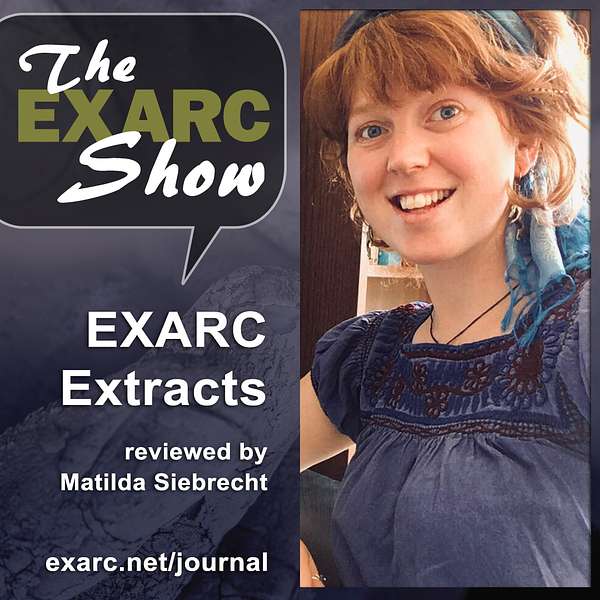
The EXARC Show
Dive into the fascinating world of experimental archaeology, where scientists, craftspeople, sound-experts, musicians, artists and re-enactors come together to recreate the past. They investigate human activities from a wide range of eras, areas and civilizations. Their work involves both the use of traditional materials and techniques but increasingly also modern digital technology.
Our three formats are ‘Encounters’ with experts within the field, ‘Showcases’ of the work and projects of EXARC members, and ‘Extracts’ from our quarterly EXARC Journal.
The EXARC Show
EXARC Extracts 2023/3
The 2023/3 EXARC Journal is bringing you four reviewed and eight mixed matter articles. All the articles are open access to allow for free exchange of information and further development of our knowledge of the past.
The reviewed articles come from Denmark, United Kingdom and two from Italy. Two of them concern metal production – Henriette Lyngstrøm’s article on drawing wire from bog ore iron and Mauro Fiorentini’s article on casting a copper axe. Another article by Francesca Tomei and Juan Ignacio Jimenez Rivero deals with pottery production. The last article by a collective of Italian researchers is dedicated to garum, one of the most famous sauce in Roman cuisine.
In the mixed matters section you can find reports on conferences and events including the EAC 13, which took place in Torun Poland in May 2023, the RETOLD meeting in Sibiu, Romania and Archaeology Days in Kernave, Lithuania. You can also find there reviews of Rethinking Heritage for Sustainable development and Draft animals in the Past, Present and Future.
Welcome to EXARC Extracts with me, Matilda Siebrecht, as we summarise the latest reviewed articles from the most recent issue of the EXARC Journal.
Hello and welcome to this summer edition of EXARC Extracts. First up we have Garum Sardiniae in Tabula: Rediscovering the Ancient Taste of Roman Cuisine, written by Riccardo Grasso, Tania Piga, Alessio Gorga, and Manuel Mainetti [again, as with every episode, I apologise profusely for any mispronunciations that I might make of any of the authors]. This article looks at Garum, which is a famous fish sauce in Roman cuisine that goes all the way back to ancient Rome, where it was very highly valued. The authors aimed to reproduce the sauce using the wide range of historical and archaeological evidence surrounding the process as a guide, in order to suggest a possible method for making Garum, as this part still remains a mystery. The historic background to the process, as well as the experiments themselves, are documented in detail - so I might not recommend reading this one over lunch!
Next is an article entitled Casting a Copper Age Axe Using a Replica of the Marl Mould Found in Baffoni Cave by Mauro Fiorentini. The original mould was discovered during an archaeological expedition in the Baffoni Cave between 1952-1954. Further analysis was then carried out on the mould in 2020, and discovered that rather than being made of clay, as was originally assumed, the mould was actually made from a similar material known as marl. Considering the other finds that were discovered at the site, the author aimed to test one of the hypotheses, which is that this mould would have been used for metalworking. Experiments were therefore undertaken to use a range of replicas of the mould in order to recreate a bronze dagger similar to one also found in the Baffoni cave, and to melt copper, with some very enlightening results.
The third article is simply called Drawing Wire written by Henriette Lyngstrøm. As the title suggests, the experiments undertaken by the author focussed on drawing wires, but uniquely they focussed on wires of iron made from bog ore, on which there have been very few experiments to date. The paper focusses on the construction of chainmail, which of course requires wires to be drawn that are then cut into rings which are attached together in rows to create the chainmail clothing. It is a relatively short article, but incredibly detailed in describing the processes and chemistry behind the experiments.
The final peer-reviewed article of this edition looks at Experimenting with the Ancient Greek Pottery Production Process from Clay Selection to Firing in a (Re)constructed Updraft Kiln, written by Francesca Tomei and Juan Ignacio Jimenez Rivero. The aim of this project was to reproduce the Hellenistic Greek (so 4-3rd century BC) pottery production process, focussing in particular on the influence of local raw material and climatic conditions, and how it may have affected the creation of social networks in the local community. All of the stages of the experiment are very well documented, including research and preparation, the selection and processing of clay, the making of the mud bricks and perforated floor, wheel throwing the pottery, building the kiln, stacking the kiln and building the dome, and finally firing.
So only four peer-reviewed articles in this edition of the EXARC Journal, but as always, we also have several unreviewed Mixed Matters articles. Three book reviews this time: Rethinking Heritage for Sustainable Development by Sophia Labadi, reviewed by Jordana Maguire, Fragments of the Bronze Age by Matthew G. Knight, reviewed by Giovanna Fregni, and Draft Animals in the Past, Present and Future by Claus Kropp and Lena Zoll, reviewed by Rena Maguire. There are also several event reviews: RETOLD Meeting at ASTRA, Sibiu, March 2023, reviewed by George Tomegea, Archaeology Days in Kernave 2023, reviewed by Yarema Ivantsiv and Maria Ivantsiv, and of course the review of this year’s EAC13 EXARC Conference, Torun, Poland, May 2023, by Phoebe Baker, Giovanna Fregni, and Jess Shaw. There is also a very interesting article on RETOLD: A SWOT Analysis by George Tomegea, and a short article discussing Glass Lamps, a Few Points, by Karl Jakob Lamberth.
This was EXARC Extracts. If you want to find out more about the research mentioned in this episode, check out the latest edition of the EXARC Journal, which can be accessed online at exarc.net/journal.